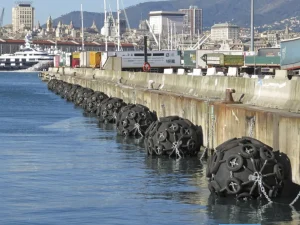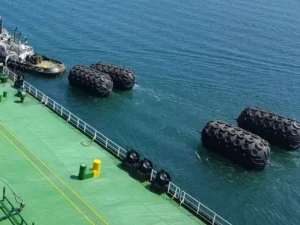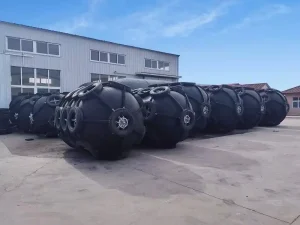Fender sind ein wesentlicher Bestandteil der maritimen Industrie. Sie erhöhen die Sicherheit und Langlebigkeit von Schiffen und Booten. Es gibt verschiedene Arten von Fendern, aber die Yokohama-Fender sind die beliebtesten. Ihre einzigartigen Eigenschaften zeichnen sie aus. Trotz ihrer hervorragenden Eigenschaften fragen sich viele: Warum Yokohama-Fender?
Diese Frage kann für jemanden, der neu in dieser Branche ist, verwirrend sein. Ich weiß, dass die Senioren dafür bekannt sind, wie gut diese Fender sind! Aber Neulinge verstehen ihren Umfang nicht. Die umfangreiche Verwendbarkeit dieser Fender lässt sie darüber nachdenken, warum sie gegenüber anderen bevorzugt werden. In diesem Artikel werden diese Fragen geklärt. Am Ende werden Sie ungehörte Fragen haben!
Überblick über Yokohama Fender

Pneumatische oder schwimmende Fender sind die anderen Bezeichnungen für diese Yokohama-Fender. Dabei handelt es sich um aufblasbare Schiffspuffer, die Schiffe vor Stößen schützen. Sie wurden erstmals in den 1950er Jahren von einem Yokohama-Unternehmen hergestellt. Daher werden sie auch als Yokohama-Fender bezeichnet. Ihr Name steht für den Hersteller.
Lassen Sie sich nicht verwirren, denn diese Yokohama-Kotflügel sind auch Gummikotflügel. Wir haben die Gummischutzbleche diskutiert auch in unseren früheren Artikeln. Lassen Sie uns über den Herstellungsprozess dieser Yokohama-Kotflügel sprechen. Denken Sie daran, dass sie aus synthetischem Gummi hergestellt werden. Und warum? Dieser Kautschuk ist robust und hält extremen Belastungen stand.
Der Körper dieser Yokohama-Kotflügel besteht aus mehreren Schichten, die ihre Festigkeit erhöhen. Der Gummi sorgt zusammen mit der Gewebeverstärkung für eine hervorragende Festigkeit. Außerdem werden diese Schichten weiter erhitzt, was ihre Zähigkeit erhöht. Danach werden die Kotflügel einem Formgebungsprozess unterzogen.
Während der Formgebung werden diese Kotflügel auch auf ihren Luftdruck geprüft. Die Hersteller prüfen, ob sie die Luft im Inneren halten oder nicht. Darüber hinaus ist auch die Wirksamkeit der Kompression gegen Stöße ein kritischer Punkt. Hier sind die wesentlichen Bestandteile von Yokohama Kotflügeln:
- Schwenken
- Ketten
- Flansch
- Schäkel
- Abschleppring
- Gummi-Manschette
Sobald sie fertig sind, werden sie auf Schiffen und Booten installiert. Sie zeichnen sich durch ihre Kompression aus. Wenn Schiffe andocken, stoßen diese Fender mit den Andockstrukturen zusammen. Diese Yokohama-Fender absorbieren den Aufprall und verhalten sich wie ein Kissen. Das Schiff spürt den Ruck nicht und bleibt in guter Form.
Warum sollten Sie sich für Yokohama-Kotflügel entscheiden?
Sie können argumentieren, dass alle Arten von Gummifängern Stöße absorbieren. Warum sollte ich also die Yokohama-Schutzbleche verwenden? Sie haben Recht, die Funktion dieser Schutzbleche ist ähnlich wie bei anderen Schutzblechen. Sie unterscheiden sich jedoch durch ihre Effektivität und Effizienz von anderen. Lassen Sie uns eintauchen und diskutieren, warum wir uns für Yokohama-Kotflügel entschieden haben.
1- Aufblasbares Design
Herkömmliche Fender sind massiv und starr, wodurch sie Stöße weniger gut abfedern können. Infolgedessen spürt das Schiff auch einige Stöße, was auf mangelnden Schutz hinweist. Die Yokohama-Fender hingegen sind aufblasbar. Das bedeutet, dass man sie mit Luft füllen kann. Das ist praktisch, denn diese Luft hilft den Fendern, sich zusammenzudrücken.
Durch die Kompression wird die Aufprallenergie gleichmäßig verteilt. Auf diese Weise absorbieren die Yokohama-Fender mehr Aufprallenergie und sorgen dafür, dass das Schiff während der Kollision sicher ist. Die Kompression dieser Fender trägt zu ihrer Flexibilität bei. Sie können auf hochbelasteten Schiffen eingesetzt werden und absorbieren problemlos extreme Stöße.
2- Strapazierfähigkeit und Langlebigkeit
Wie bereits erwähnt, werden die Yokohama-Schutzbleche hauptsächlich aus synthetischem Gummi hergestellt. Dieses Material ist solide und bietet eine außergewöhnliche Haltbarkeit. Durch die Verwendung dieses Materials sind diese Schutzbleche auch sehr robust. Sie halten extreme Belastungen und Stöße problemlos aus. Darüber hinaus verschlechtert sich ihre Qualität nicht, wenn sie unter rauen Wetterbedingungen eingesetzt werden. Kein anderer Kotflügel kommt in puncto Haltbarkeit an Yokohama heran.
3- Vielseitige Anwendungen
Was ich an Yokohama-Schutzblechen liebe, ist ihre Vielseitigkeit. Sie können unter verschiedenen Bedingungen eingesetzt werden. In der Schifffahrtsindustrie werden Gummifender zum Beispiel bei verschiedenen Schiffsoperationen eingesetzt. Diese sind wie folgt:
- Schiff-zu-Dock-Verankerung
- Offshore-Öl- und Gasplattformen
- Andocken von Marine- und Militärschiffen
- Anlegen von Container- und Massengutfrachtern
- Schiff-zu-Schiff (STS)-Umschlagoperationen
- Be- und Entladen von Fracht
Die Yokohama-Fender können bei all diesen Vorgängen eingesetzt werden. Sie können entweder an den Andockstrukturen oder an Schiffen angebracht werden. Ihre Funktionalität ist in beiden Fällen gleich gut. Auch beim Transfer von Schiff zu Schiff kommen diese Fender zum Einsatz. Auf diese Weise nähern sich beide Schiffe während der Fahrt einander an. Ihr Zusammenstoß verursacht keinen Ruck.
4- Widerstandsfähig gegen Überdruck
Die Marineindustrie besteht nicht nur aus kleinen Schiffen. Vielmehr geht es um das Andocken von Schwerlastschiffen, die schwere Lasten tragen. Ihre Ladung übt beim Anlegen extremen Druck und Stress auf die Andockstrukturen aus. Diese Belastungen zerstören die Andockstrukturen, wenn die Fender nicht stabil sind.
In solchen Fällen kommen diese Yokohama Kotflügel zum Einsatz. Sie sind aus haltbarem Gummimaterial hergestellt. Daher können sie extremen Druck effizient aushalten und ihre Integrität bewahren. Diese Fähigkeit, extreme Stöße zu absorbieren, zeichnet sie aus. Mit Yokohama-Fendern können Docks jede Art von Schiffen problemlos aufnehmen.
5- Kostengünstig & Erschwinglichkeit
Fender für die Schifffahrt haben unterschiedliche Preise und Qualitäten. Einige von ihnen sind sehr teuer. Die Hersteller werben mit ihnen als High-End- oder Premium-Fender. Auf der anderen Seite gibt es einige, die billig sind, aber nicht effizient arbeiten. Diese Yokohama-Fender liegen in der Mitte. Ihr Preis ist nicht zu hoch.
Aber ihre Wirksamkeit ist besser als die von Premium- oder High-End-Gummischutzblechen. Daher werden sie als preiswert angesehen. Betrachtet man ihre Qualität in Bezug auf den Preis, so bieten diese Schutzbleche einen außergewöhnlichen Wert. Ihr erschwinglicher Preis ist es, der die Leute dazu bringt, sie zu kaufen. Kurz gesagt, Yokohama-Kotflügel bieten ein ausgewogenes Verhältnis zwischen Preis und Qualität.
Wie wählt man die richtigen Yokohama-Kotflügel aus?

Ein japanisches Unternehmen stellt Yokohama-Kotflügel mit einem ausgezeichneten Qualitätssicherungssystem her. Sie müssen sich also keine Sorgen um ihre Leistung machen. Allerdings müssen Sie bei der Auswahl der Größe und Tonnage vorsichtig sein. Die falsche Größe wird den Zweck nicht effektiv erfüllen. Denken Sie daran, dass verschiedene Schiffe unterschiedliche Größen haben.
Bei der Auswahl sollte man sich daher an der Größe der Schiffe orientieren. Neben der Größe sollten Sie auch an die Druckfestigkeit denken. Sie gibt an, wie viel Druck ein Fender problemlos aushalten oder absorbieren kann. Hier ist die Tabelle mit den spezifischen Größen und Druckstufen für kluge Entscheidungen.
| Fendergröße (Durchmesser x Länge) | Druckstufe (kPa) |
|---|---|
| 0,5 m x 1,0 m | 50 kPa |
| 1,0 m x 1,5 m | 50-80 kPa |
| 1,2 m x 2,0 m | 50-80 kPa |
| 2,0 m x 3,5 m | 80-100 kPa |
| 2,5 m x 5,5 m | 80-100 kPa |
| 3,3 m x 6,5 m | 100-150 kPa |
Die kleineren Fender sind für kleine Boote geeignet. Sie haben eine geringe Druckbelastbarkeit. Auf der anderen Seite sind die größeren Fender für größere Schiffe geeignet. Sie haben eine höhere Druckbelastbarkeit. Sie sollten die Fendergröße anhand der Größe Ihres Schiffes oder Bootes auswählen.
Warum werden pneumatische Fender auch als Yokohama-Fender bezeichnet?

Wie ich bereits sagte, sind sowohl pneumatische als auch Yokohama-Kotflügel das Gleiche. Mit einfachen Worten, es sind zwei Namen für eine Sache. Es stellt sich jedoch die Frage, warum die pneumatischen Schutzbleche üblicherweise Yokohama genannt werden. Der Grund dafür ist, dass das Unternehmen Yokohama als erstes die pneumatischen Schutzbleche hergestellt hat.
Dies ist ein japanisches Unternehmen, das Kotflügel und andere Gummiprodukte herstellt. Dieses Unternehmen erfand 1958 pneumatische Kotflügel. Aufgrund dieser Erfindung werden die pneumatischen Kotflügel Yokohama genannt. Vor 1958 gab es keine pneumatischen Fender. Die Schifffahrtsindustrie musste feste Fender verwenden, die nicht zuverlässig waren.
Bestellen Sie Yokohama-Fender für Ihr Schiff? Sie fragen sich vielleicht, welchen Namen Sie bei der Bestellung verwenden sollten pneumatische Fender von einem Lieferanten, oder? Sie können entweder Luftkotflügel oder Yokohama-Kotflügel nennen. Alle Anbieter wissen, dass diese Fender mehrere Namen haben. Sie können sie sogar schwimmende Fender nennen. Denken Sie daran, dass alle diese Namen dasselbe bedeuten.
Schlussfolgerung
Die Fender von Yokohama sind in der Schifffahrtsindustrie sehr beliebt geworden. Fast alle Schiffe und Boote verwenden sie, um ihre Sicherheit und ihren Schutz zu gewährleisten. Es gibt viele Gründe für ihre Beliebtheit. Stoßdämpfung, Langlebigkeit und Kosteneffizienz stehen an erster Stelle. In diesem Leitfaden habe ich alles über diese Fender erklärt. Ich hoffe, dass Sie jetzt in der Lage sind, bei der Auswahl dieser Fender fundierte Entscheidungen zu treffen.
